
The Battle of the Little Bighorn, known to the Lakota and other Plains Indians as the Battle of the Greasy Grass, and also commonly referred to as Custer's Last Stand, was an armed engagement between combined forces of the Lakota Sioux, Northern Cheyenne, and Arapaho tribes and the 7th Cavalry Regiment of the United States Army. The battle, which resulted in the defeat of U.S. forces, was the most significant action of the Great Sioux War of 1876. It took place on June 25–26, 1876, along the Little Bighorn River in the Crow Indian Reservation in southeastern Montana Territory.

George Armstrong Custer was a United States Army officer and cavalry commander in the American Civil War and the American Indian Wars.

The Waler is an Australian breed of horse developed from horses that were brought to the Australian colonies in the 19th century. The name comes from their breeding origins in New South Wales; they were originally known as "New South Walers".

A riding boot is a boot made to be used for horse riding. The classic boot comes high enough up the leg to prevent the leathers of the saddle from pinching the leg of the rider, has a sturdy toe to protect the rider's foot when on the ground and has a distinct heel to prevent the foot from sliding through the stirrup. The sole is smooth or lightly textured to avoid being caught on the tread of the stirrup in the event of a fall.
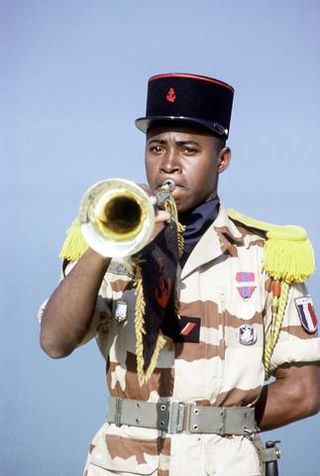
A bugle call is a short tune, originating as a military signal announcing scheduled and certain non-scheduled events on a military installation, battlefield, or ship. Historically, bugles, drums, and other loud musical instruments were used for clear communication in the noise and confusion of a battlefield. Naval bugle calls were also used to command the crew of many warships.
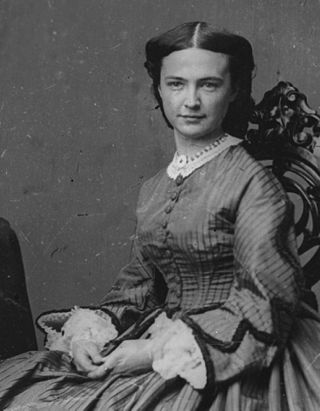
Elizabeth Bacon Custer was an American author and public speaker, and the wife of Brevet Major General George Armstrong Custer, United States Army. She spent most of their marriage in relative proximity to him despite his numerous military campaigns in the American Civil War and subsequent postings on the Great Plains as a commanding officer in the United States Cavalry.

The Battle of Trevilian Station was fought on June 11–12, 1864, in Union Lt. Gen. Ulysses S. Grant's Overland Campaign against Confederate Gen. Robert E. Lee's Army of Northern Virginia. Union cavalry under Maj. Gen. Philip Sheridan fought against Confederate cavalry under Maj. Gens. Wade Hampton and Fitzhugh Lee in the bloodiest and largest all-cavalry battle of the war.

Bloody Knife was an American Indian who served as a scout and guide for the U.S. 7th Cavalry Regiment. He was the favorite scout of Lieutenant Colonel George Armstrong Custer and has been called "perhaps the most famous Native American scout to serve the U.S. Army."

Jodhpurs, in their modern form, are tight-fitting trousers to the ankle, where they end in a snug cuff, and are worn primarily for horse riding. The term is also used as slang for a type of short riding boot, also called a paddock boot or a jodhpur boot, because they are worn with jodhpurs. According to Mayer, "Jodhpurs … exemplify the material and cultural exchanges between Britain and its Indian colony in the nineteenth and early twentieth centuries."
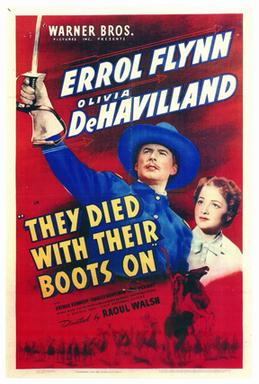
They Died with Their Boots On is a 1941 American black-and-white Western film from Warner Bros. Pictures, produced by Hal B. Wallis and Robert Fellows, directed by Raoul Walsh, that stars Errol Flynn and Olivia de Havilland.

Comanche was a mixed-breed horse who survived George Armstrong Custer's detachment of the United States 7th Cavalry at the Battle of the Little Bighorn.
George Armstrong Custer (1839–1876) was a United States Army cavalry commander in the American Civil War and the Indian Wars. He was defeated and killed by the Lakota, Northern Cheyenne, and Arapaho tribes at the Battle of the Little Bighorn. More than 30 movies and countless television shows have featured him as a character. He was portrayed by future U.S. president, Ronald Reagan in Santa Fe Trail (1940), as well as by Errol Flynn in They Died With Their Boots On (1941).

The 1st West Virginia Cavalry Regiment served in the Union Army during the American Civil War. Although it started slowly, it became one of the most active and effective of the West Virginia Civil War regiments—and had 14 Medal of Honor recipients, the most for any West Virginia regiment during the war. It was originally called the 1st Virginia Cavalry, not to be confused with the Confederate 1st Virginia Cavalry. Some reports added "Union," "Loyal" or "West" when identifying this regiment. After the Unionist state of West Virginia was officially admitted to the Union in 1863, the regiment became the 1st West Virginia Cavalry Regiment. The National Park Service identifies it as the 1st Regiment, West Virginia Cavalry.
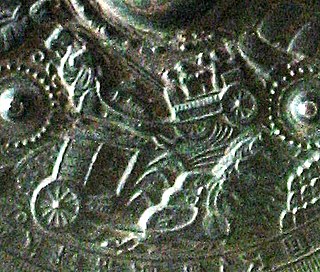
Horses in East Asian warfare are inextricably linked with the strategic and tactical evolution of armed conflict throughout the course of East Asian military history. A warrior on horseback or horse-drawn chariot changed the balance of power between the warring civilizations throughout the arc of East Asian military history.
The Battle of Honsinger Bluff was a conflict between the United States Army and the Sioux people on August 4, 1873 along the Yellowstone River near present-day Miles City, Montana. This was U.S. territory acquired from the Crows in 1868. The main combatants were units of the U.S. 7th Cavalry under Lt. Col. George Armstrong Custer, and Native Americans from the village of the Hunkpapa medicine man, Sitting Bull, many of whom would clash with Custer again approximately three years later at the Battle of the Little Big Horn in the Crow Indian Reservation.
Boots and Saddles is an American Western television series that aired in syndication from 1957 to 1959.

Samuel Langhorne Clemens , well known by his pen name Mark Twain, was an American author and humorist. Twain is noted for his novels Adventures of Huckleberry Finn (1884), which has been called the "Great American Novel," and The Adventures of Tom Sawyer (1876). He also wrote poetry, short stories, essays, and non-fiction. His big break was "The Celebrated Jumping Frog of Calaveras County" (1867).
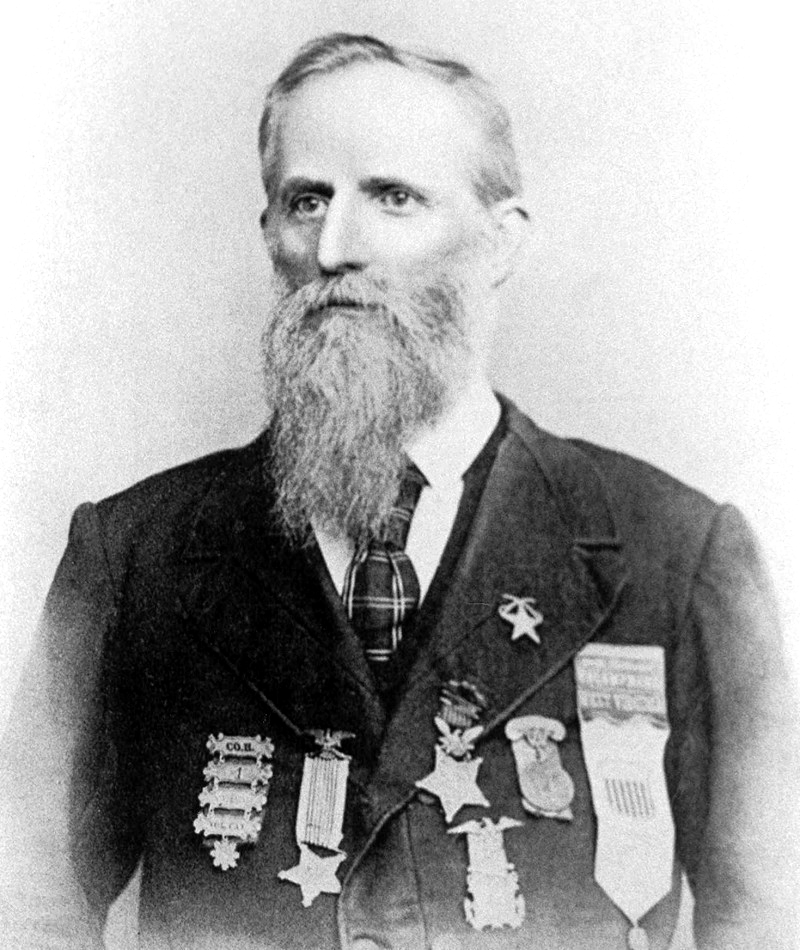
Francis Marion Cunningham was a United States' soldier and native of Pennsylvania who fought with Company H of the 1st West Virginia Cavalry during the American Civil War. Cunningham received his nation's highest award for bravery during combat, the U.S. Medal of Honor, for his action during the Battle of Sailor's Creek in Virginia on April 6, 1865. That award was conferred on May 3, 1865.
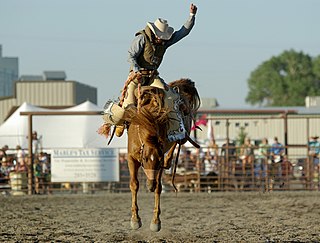
A bucking horse is any breed or either gender of horse with a propensity to buck. They have been, and still are, referred to by various names, including bronco, broncho, and roughstock.
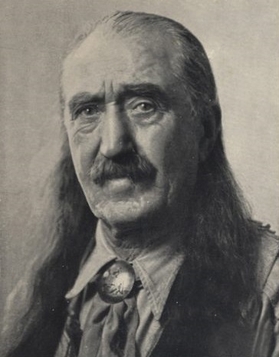
Julius Mortimer "Bronc(h)o Charlie" Miller was an American horse tamer and Pony Express rider. He was born on the trail in California to parents travelling west for the California Gold Rush. At the age of 11 Miller claimed to have become the youngest ever Pony Express rider, claiming to have done so after witnessing a horse arrive without its rider at the station in Sacramento. Miller then worked as a horse trainer, from which he earnt his nickname, including a period working on Teddy Roosevelt's cattle ranch. Afterwards he became a performer demonstrating roping techniques, horse riding and knife throwing. On his travels he met and married Carrie Potter, who joined and became a target girl in his act.

















